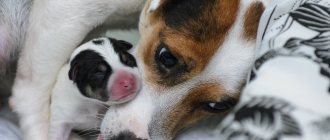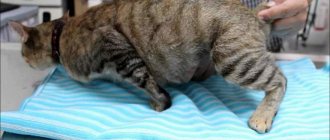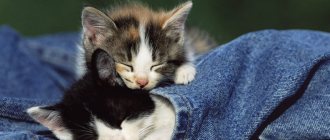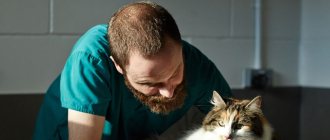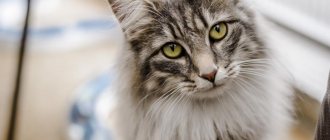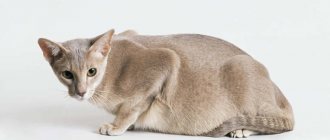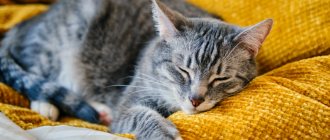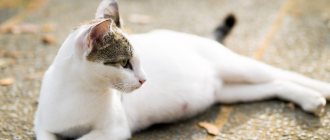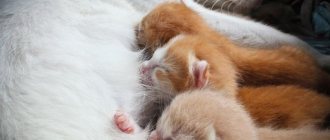How to prepare for the birth of a dog or cat?
Physiology of childbirth in dogs: from A to Z
In this article we will tell you how a normal birth should proceed, when you should and when you shouldn’t worry, in which cases you need to go to the clinic immediately, and when you should just wait.
Do I need to go to the veterinary clinic or call a veterinarian?
Cat giving birth
- This is a normal and natural process. Human intervention should only occur when non-intervention would lead to a problem. Healthy animals give birth on their own and do not require human assistance. This does not mean that childbirth should not be monitored, because childbirth is an unpredictable process, and, unfortunately, sometimes something can go wrong.
How many times a day and in what quantity should a small infant kitten separated from its mother be fed?
The kitten is still very small, its eyes are just opening, so it has to be force-fed from a pipette! I would like to know how much and how often he needs to be fed, because it is so impossible to understand whether he is full or not!
In order to determine whether a kitten is full or not, pay attention to its behavior: well-fed cubs sleep peacefully, and hungry ones squeak, crawl or suck the finger extended to them
Dilute concentrated milk powder in fennel broth to the consistency of liquid gruel, adding a little cream.
Starting from the eighth day, babies should be given liquid vitamin preparations prescribed by a veterinarian every other day. Raw cow's milk is contraindicated for newborn kittens. You can use ready-made cat milk or dry formulas - cat milk substitutes - which are sold in veterinary pharmacies.
In any of the above cases, you will need a bottle and nipple (some manufacturers of ready-made cat milk put the bottle and nipple inside a jar of dry formula). They can also be purchased at veterinary pharmacies. You can use a plastic eye dropper or syringe (without a needle). The main requirement is sterility. Bottles and teats should be cleaned and boiled regularly.
The food supply is prepared for no more than 24 hours and stored in the refrigerator. The food must be heated to 38 °C, and when giving it, you must ensure that the kitten sucks milk itself. Milk should not be introduced by force, as the baby may choke. When a kitten falls asleep or has milk bubbles coming out of its mouth, it means it is already full.
It is important that kittens suckle themselves through the narrow holes in the nipple and prepare themselves for the “drinking work”. Do not give milk through a wide opening
This often leads to milk entering the respiratory tract and causing illness.
Source
How is childbirth different for pets?
Childbirth in cats
Cats usually give birth faster than dogs.
The harbingers of labor take only a few hours for them; the birth itself and the intervals between babies pass faster. However, if there are complications or abnormal births, they are more likely to end in caesarean section in cats than in dogs.
An important point to know!
Remember that even normal childbirth is extremely stressful for the body. But it is your pet who is giving birth, not you, so you should not increase stress by infecting your pet with your nervousness. No matter how much what is happening scares you, control yourself, talk to the animal in a calm and confident voice, know that it is from you that it expects support. Prepare for childbirth in advance: read the literature, enlist the help of a doctor, find out the number of a 24-hour clinic to be fully prepared.
Do not panic! Animals sense your condition and may become frightened, which can lead to them hiding from you. Create the most calm and comfortable environment for the animal. You shouldn’t grab it and rush to the clinic to give birth if there is no reason for this. Traveling is an additional stress, which, especially in cats, can lead to the cessation of labor. If you are very worried and unsure of your abilities, it is better to invite a doctor to your home. You can call the clinic and get doctor's advice.
We will tell you how a normal, uncomplicated birth proceeds.
How do you know when an animal is due to give birth?
There are even special online calendars on the Internet that are very convenient. Enter the mating date and get the estimated due date. If you are not sure or do not know the exact date, you can do an ultrasound to determine the date. A good diagnostician uses ultrasound to determine the period with an accuracy of up to a week.
However, even the best doctor can make a mistake with the number of fetuses. The fact is that the uterus in animals is two-horned, shaped like the letter V, so during research you can easily make a mistake by counting the same fetus twice. The exact number of babies can only be determined by x-rays, but this method is not recommended for pregnant women. If the owner insists, then he takes the risks for the consequences.
What to do if your cat has little or no milk
There is no need to self-medicate, but rather consult a veterinarian for help. This is due to the fact that lactation disturbance in a young cat that has given birth requires an integrated approach, with the use of medications. If the hormonal balance is disturbed, women in labor need to be administered a special drug - Ovariovit - for 2 weeks.
It is important to ensure normal nutrition by giving more liquid food. It is recommended to introduce lean meat and chicken yolks into your cat's diet. It is advisable to give kefir and cottage cheese from dairy products.
Note! It is not recommended to conduct food experiments and introduce new foods unknown to the cat into the diet.
Due to the fact that there can be many reasons for a small amount of milk or its absence in cats that have given birth, it is recommended to consult a qualified veterinarian to identify such pathological conditions as nervous shock, infectious lesions and inflammatory processes.
Precursors of childbirth and symptoms of an imminent birth of a cat...
External manifestations of imminent labor are called precursors and are similar in dogs and cats.
- Animal behavior,
- lactation,
- appetite,
- frequent urination,
- prolapse of the abdomen,
- loop softening,
- thermometry.
A week before giving birth, the animal’s behavior changes
. This is due to the growth of the hormone estrogen, which causes contraction of the muscle fibers of the uterus (contraction). This increases anxiety and stimulates the animal to build a nest. Dogs begin to dig, cats begin to build a “nest.” It is recommended to provide the animal with a box or house in which it will feel safe.
Lactation
– does not always appear and not for everyone. This is not a completely accurate sign of the harbingers of labor. In some dogs it may appear from the 40th day of pregnancy, and in others only after birth.
Appetite.
In general, the appetite before birth worsens, or may become selective, that is, the animal may become more picky about food.
There are animals that eat even during the birth process, but these are exceptional cases, of course. And some people completely lose their appetite before giving birth, which is a very bad symptom and can lead to ketoacidosis
. If the animal does not eat for more than a day, and labor does not begin, you should consult a doctor. So, everything is individual.
Frequent urination
– normal before labor, usually associated with increased uterine contractions. Urinating in inappropriate places can be an involuntary leakage of urine. Sometimes the animal simply does not have time to “run” or wait until the walk.
«Abdominal prolapse
“- is considered perhaps the surest sign of imminent labor, but it is associated not with the harbingers of labor, but with an increase in the weight of the fetus. The most active weight gain occurs in the last weeks, and the growth of babies continues until the very birth, so the stomach drops under the gravity of the uterus. The more fetuses there are, the more pronounced the prolapse of the uterus is. If the animal has only one fetus, then uterine prolapse may not be noticeable at all.
Loop softening
– she is preparing for childbirth, so she becomes softer and more pliable a couple of days before giving birth.
One of the most accurate precursors of labor is Thermometry
. It is of key importance in determining the period of labor.
For control, it is advisable to measure the temperature 1-2 times a day, starting from the 55th day of pregnancy. When we know what it usually is, we can determine when they will start. A drop in temperature by 2 degrees (to 37) usually indicates the imminent onset of labor.
Physiology of childbirth
In ripened fetuses, cortisol (stress hormone) is formed, which passes the placental barrier, it stimulates the mother’s production of prostaglandins. Prostaglandins dissolve the corpus luteum of pregnancy, which produces the pregnancy hormone progesterone. The amount of progesterone drops sharply and labor begins.
In addition, the amount of estrogens increases, which increases the sensitivity of receptors to oxytocin. The contraction of the uterus increases. The hormone relaxin, produced by the placenta, stimulates the dilatation of the cervix and prepares it for the expulsion of the fetus.
Colostrum
On average, a cat's gestation period is 65 days. Lactation can begin a few days before birth or directly during labor. For the first few days, the cat feeds the offspring with colostrum, which differs in color and structure from milk.
Colostrum is a concentrate of fats, proteins, vitamins and antibodies. When kittens are born their intestines are sterile. Colostrum contains a high concentration of beneficial bacteria that colonize the intestines and help kittens digest milk. The color of colostrum can vary from cream to yellowish.
Hormones prolactin and lactation hormone
The hormone prolactin is a “maternal behavior” hormone and a lactation hormone.
Stages of childbirth in detail.
Childbirth is divided into 3 stages, each stage has its own time interval.
The intervals and duration of labor are unpredictable, and past births are not an indicator. One time an animal can give birth in a couple of hours, another time the birth will last almost a day and both options can be the norm.
Stage 1 – harbingers of labor.
This is the most painful stage for the animal and the owner. Behavior changes as the uterus contracts, but we do not see this in the abdomen. The dog (cat) is breathing heavily and digging or making a nest. The period can take up to a day. To confirm the onset of labor in dogs, a progesterone test can be done. Its decrease confirms the onset of labor.
Exception: In cats, progesterone is also produced by the placenta, so the drop in progesterone will not be as significant as in dogs. A strong decrease in cats occurs only the day after birth.
Similarly, in the case of “single puppy/kitten syndrome”, one fetus may not cause such a cascade of reactions, as a result of which pregnancy may be delayed. And there is no decrease in temperature, since progesterone does not drop and labor does not begin for a long time.
Features of mother feeding kittens
Immediately, as soon as the pet lambs, it begins to actively produce first-born milk - colostrum. It is unusually rich in specific antibodies that provide newborn kittens with immune protection in the first days.
As lactation improves, the antibodies in the colostrum leave and it becomes milk. During the period when the cat feeds the kittens with milk, they receive all the necessary nutrients - proteins, fats, carbohydrates, vitamins and minerals necessary for the functioning of natural processes in the babies' bodies.
During the first 5-7 days after birth, kittens are often attached to their mother's nipples, thus establishing the lactation process. The number of applications ranges from 10 to 14 times a day. Week-old kittens begin to maintain an interval of several hours between feedings, and their number is reduced to 8 times. At the age of 1 month, kittens eat up to 6 times a day.
How long a cat nurses her kittens depends on several factors, but on average this period ranges from 3 to 4 months. It happens that the lactation period is delayed if there are not many offspring (2-3 kittens). If there are more babies, the period of breastfeeding is reduced.
Some cats stop the process after a four-week feeding period, keeping their offspring away from the nipples. It also happens that a cat that has given birth refuses to feed the kittens at all.
Regardless of the cat’s individual characteristics, the owner must pay attention to the quality of the mother’s food. A nutritious diet of natural food or high-quality balanced dry food provides the animal’s body with all the necessary minerals and nutrients, allowing you to extend the lactation period
It is important that a nursing cat’s diet contains a sufficient amount of calcium and the amino acid taurine, which helps maintain the normal functioning of the cardiovascular system and other internal organs. A criterion that influences the duration of the lactation period is the physiological state of the cat.
Various chronic diseases or acute inflammatory processes, complications after childbirth, infection with helminths and other parasites lead to a decrease in the overall milk production of the animal and the lactation period
A criterion that influences the duration of the lactation period is the physiological state of the cat. Various chronic diseases or acute inflammatory processes, complications after childbirth, infection with helminths and other parasites lead to a decrease in the overall milk production of the animal and the lactation period.
A healthy cat feeds kittens for about one month without additional feeding. Next, a gradual introduction of solid food is necessary, since even with good lactation, rapidly growing kittens no longer have enough milk for normal development. It is recommended for kittens to add lean meats (turkey is preferable), veal, low-fat cottage cheese and fermented milk products (yogurt) in small portions.
The number of feedings for a kitten is reduced to 3 times a day, and at the age of 2-3 months, older babies should switch to independent feeding. Changes occur in the body of most kittens and milk ceases to be digested normally, lactose deficiency develops.
The cat owner must closely monitor his pet if he does not want to get another litter soon after the first. A cat can become pregnant when nursing kittens as early as 4 weeks after giving birth. Some female domestic cats go into heat 1.5 weeks after giving birth.
You should not allow a new mother to come into contact with a cat, as this can lead to an unwanted pregnancy, aggravated by dangerous and serious consequences for the cat’s body. Frequent childbirth leads to exhaustion of the body, the organs of the reproductive system and the musculoskeletal system suffer.
After pregnancy and childbirth, the animal’s body must recover and get stronger, otherwise there is a risk of producing non-viable offspring and developing severe complications in the form of endometritis and pyometra.
The main signs of the imminent onset of labor:
- Anxiety, tremor, anorexia. Dilated pupils.
- Rapid breathing, sometimes with an open mouth.
- Digging, nest building.
- The temperature is about 36.7–37. The entire first stage of labor persists. By the 2nd stage it will return to normal.
- Vocalization in cats. They walk in circles and lick themselves.
- During this period, the cervix opens inside. There is no effort. There may be weak contractions that are mistaken for pushing.
- Another external manifestation of this stage of labor is the release of the mucus plug. It comes out when the cervix opens, and thick mucous discharge always comes out of the loop. It looks like a long thread hanging from a loop.
In cats, due to their cleanliness and immediate licking of anything that could dirty them, the removal of the plug can be difficult to notice. But often 1-24 hours before birth it can be noticed.
Ways of infection with worms from cats
Parasite eggs enter the human body orally (through the mouth). All you have to do is pet an infected cat, pick it up, and not wash them afterwards. Many cat lovers don't even need their hands to do this - they just kiss the cat on the nose. Thus, the worm eggs reach their final destination. The human gastrointestinal tract is an ideal place for their habitat.
But even following the rules of personal hygiene will not protect against infection if your cat is a carrier of worms. After all, she touches our things, sleeps in our place, therefore, parasite eggs end up on these surfaces. A pet with worms in almost all cases guarantees their transmission to all family members, with possible serious consequences.
Helminths are transmitted from cats to humans in the following ways:
Checking if there is milk by weight gain
In addition to observing the behavior of the kittens in the nest, you can find out whether the cat has milk by weighing it. It is believed that in the first days of life, kittens should, on average, gain 14–15 grams of live weight per day.
It is worth considering that these figures are very average and in many ways a kitten’s weight gain depends on its weight at birth, breed and individual characteristics.
At the same time, the two evidence given (calmness and weight gain) fully confirm that the cat has milk and her children are well-fed.
